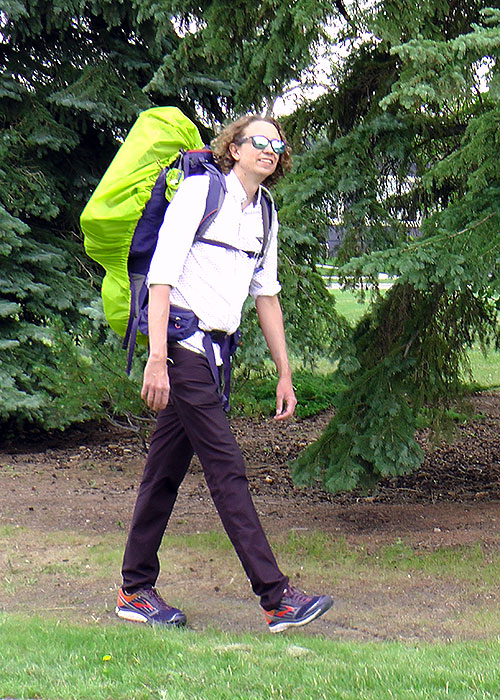Everything you need to stay safe and comfortable - and nothing more
Backcountry hiker Andrew Johnson (Machinist ’04) might be labelled a comfortable minimalist. After learning a few early lessons in overpacking (bottles of energy drinks, tins of tuna, and so on) he’s whittled down his camping list to the bare necessities. All told, they amount to about 32 pounds in a 70-litre pack he hauls as often as possible into the Rockies.
“Some would say that this is not actually packing light,” says the Machinist program technician. “I know people who will go hiking and won’t even take a sleeping pad. They won’t take pants, they’ll just wear shorts.”
But Johnson feels he’s struck a balance with his collection of must-haves. “I’m not ready to skip on the equipment that keeps me warm and dry. There’s no excessive stuff here.”
So what’s left? In order of packing, here’s a look at the 20 essentials he won’t do without.
- Sleeping bag – Johnson finds that a bag rated to -10 C suits him throughout the summer hiking season, and he gets cold easily. Down-filled is lighter, though he points out that bags with synthetic fillings will keep you warmer in humid environments.
- Tent – Light rarely comes cheap. Johnson’s weighs just over a kilogram and runs around $800. Keep in mind, you can rent good equipment, he adds.
- Food, dishes and utensils – Food is a heavier item, but obviously indispensable. Johnson makes meals and dehydrates them in advance (he recommends Excalibur dehydrators) to reduce weight. “I just add hot water and dinner is served in 60 seconds.” It also saves money on store-bought dried meals, which can also be high in sodium. Dishes nest like Russian dolls: a Fair Share food bowl contains his plastic cup that contains his a spoon. Johnson never takes a knife.
- Campsite clothes – two shirts, two pairs each of long underwear, underwear, and socks, a vest, and all of it made of light, fast-drying merino wool. Avoid cotton and denim, which take ages to dry. Johnson hikes in shorts, with a pair of long underwear beneath if necessary. No pants.
- Rain gear and such – “I bought a $12 poncho from Ikea and I think it’s the greatest poncho ever,” says Johnson. He’ll slip it over his proper raincoat to keep it as dry as possible. His rain pants can be unzipped from waist to ankle, eliminating the need to remove boots. For buggy locations, he uses a mosquito mask over his face. “It doesn’t restrict your view and it brings you some serenity.”
- Water filtration system – Johnson sets up a four-litre gravity filter at the campsite and lets it go to work, pump free. Check the owner’s manual for limitations, he advises. He draws his water from fast-running streams and has never had a problem.
- Camelbak – Loop the drinking tube on this portable water pouch through your backpack for water on the go.
- Water bottle – Johnson prefers Nalgene bottles since they can be fitted with screw-on, hand-pump water filters. Clip it onto your pack with a small carabiner so you don’t lose it en route.
- Sleeping gear – If you use a mat, get one with an inflation sack. Air from your lungs can introduce moisture, which gets cold at night. A light sleeper, Johnson also brings earplugs for campsites beside noisy streams, and a sleep mask for the midsummer nights of long-lingering sunlight. A pair of gloves and a toque don’t hurt either. “Anything that helps me get a good night sleep.”
- Down-filled coat – Keep it handy for inevitable and quick changes in mountain weather.
- Hat and sunglasses – For the hat, go light, foldable and with a wide brim. Make the hike easy on the eyes as well, particularly near glaciers, with polarized lenses.
- Pillow – An essential part of Johnson’s pursuit of a “good night’s sleep,” a tiny pillow stuffs easily into his pack.
- Flip flops – They might seem flimsy, but cheap flip flops are perfect for stream crossings and for airing out feet at day’s end. Clip them to your pack for quick access.

- Stove – Johnson picked a propane-fuelled Jetboil stove for its compact size and lightness. For an alternative, he recommends small stoves with refillable fuel tanks. That way, “you always know how much fuel you have.”
- Hiking poles – “You get an extra two points of contact,” says Johnson. Use them in streams, for pulling yourself uphill, or for saving your knees when going downhill.
- Gaiters – Damp shrubs at trailside can make for wet feet. Strap on a pair of gaiters to protect your boots and bottoms of your rain pants. Keep these ready in a pack pocket.
- Toiletries and first aid – Toothbrush, toothpaste, hand sanitizer. “Always buy the smallest quantities you can.” But don’t skimp on the mosquito spray and sunblock. As for first aid, keep it simple: remedies and bandages for burns from fire, minor cuts and bug bites. If disaster strikes, Johnson subscribes to a GPS-enabled SOS service.
- Bear spray – “You’d better have it handy,” he says. Clip it to the outside of your pack as well.
- Footwear – “I’ve started hiking in runners because they’re more comfortable.” Johnson brings boots for tougher terrain. They’re waterproof and vented.
- Pack cover – The final touch and the first line of defense against a wet pack full of wet stuff.
This list – long or short, depending on your perspective – makes for a pack that Johnson’s happy to get off his back at the end of a long walk, but he wouldn’t have it any other way. “The last hike I went on, we had every weather possible,” he says. “I felt comfortable having gear for all of that.”